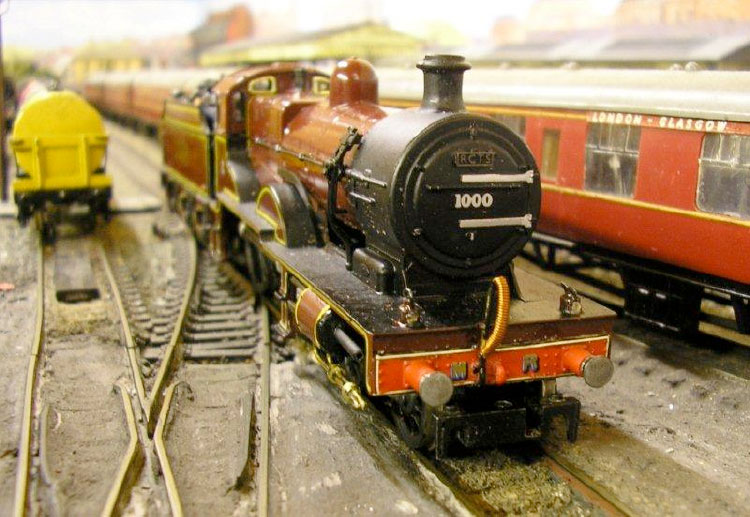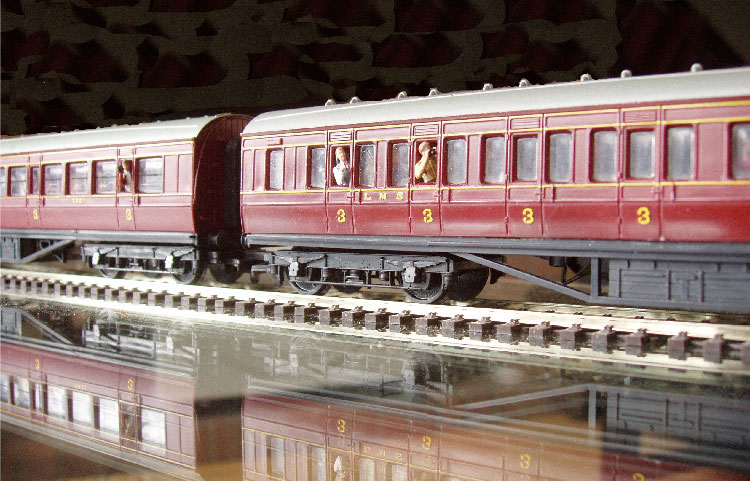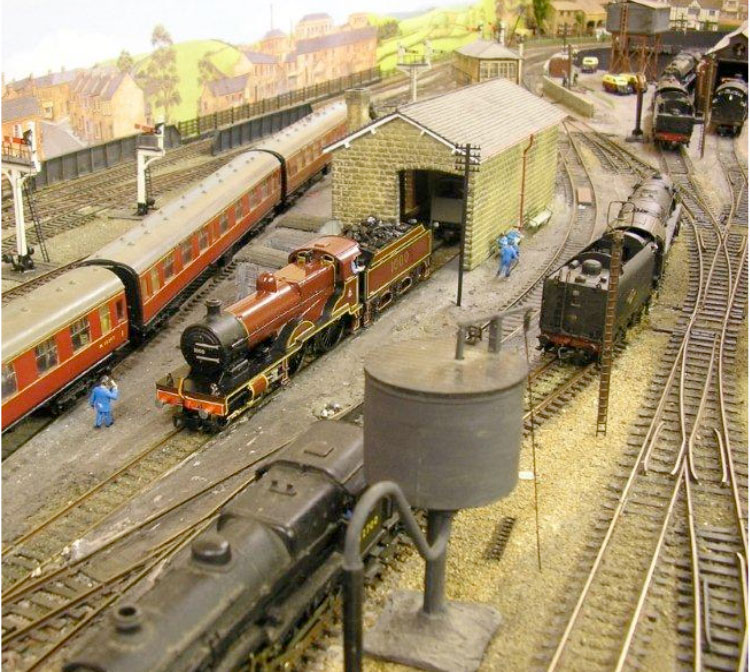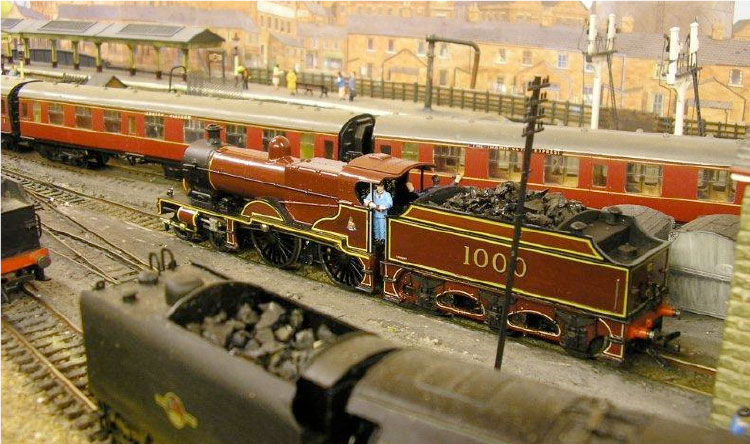We believed we had a layout to die for. But among our 37 locomotives at the time, we didn’t have a 3 Cylinder 4-4-0 Compound. To be honest, we didn’t need one, but you know how it is… what you haven’t got becomes more important than what you have got.
It was quite by chance that we read an article about the original Johnson Midland 7ft Compound 1000 and how, in 1957, instead of it being withdrawn and scrapped with all the others in the class, it was restored in its original livery to haul Steam Enthusiasts’ Tours, which were very popular in the late 1950s, due to the imminent demise of steam.
So that was to be our next project! An enthusiasts’ special, hauled by a 1902 locomotive in its original livery, working alongside Stanier’s great Pacifics, just as it did in 1959. We could have the driver waving to the crowds, who would be lining the platforms, watching in admiration. The coaches could be old stock, with people leaning out of the windows taking photographs as railway enthusiasts do.

To model this moment in history was indeed an exciting challenge. The result exceeded even our own expectations.
Success came immediately. A 1981 Hornby Midland Compound (with smoke) was for sale on Ebay. We failed to win the first model and our hearts sank, but within a couple of days, two more appeared for sale. We won the third model, paying a mere £39 for what turned out to be an amazing Hornby locomotive.
We set to work on the running gear with enthusiastic fervour, refining and modernising it to take the latest Peco points and crossovers.
WHEELS
New wheels were purchased from ‘Alan Gibson Model Railways’. They were 2/3 the width of the original Hornby wheels, with flanges 1/3 the size. The biggest gamble was to increase the 6ft 8in drivers, which Hornby had fitted up to the 7ft wheels for which number 1000 was famous. The 7ft drivers definitely looked right but the inside of the wheel arches had to be filed away to avoid contact. You can’t tell now the loco is finished, so our gamble paid off.
Axle bushes were required for the new 1/8” diameter axles and the connecting rod screws had to be filed down into a pin shape to fit into the scaled wheels. We decided to stick with the original Hornby valve gear even if it was a bit on the big side, to retain the authenticity of the model.
The front bogie wheels were also changed – same size but now with a much thinner profile to negotiate the delicate point blades.

We could not change the tender wheels. This model is tender-drive so we had to work with the original wheels. We completely removed the flanges on the middle two wheels and filed down the flanges on the other four, by 50%. We also filed these wheels down to their minimum width and adjusted their back-to-back gauge measurement.
With the new wheels, bushes and axles, the locomotive had a more engineered feel about it and, with most of the side play taken out, it ran more smoothly and more accurately over our track.
The biggest problem we encountered was the complexity of the electrics in this 1980s model. All our new wheels were insulated, so when we put it on the track and turned on the power, nothing happened. Only after a day of trial and error did we realise that the loco and tender chassis were negative, all the wiring, both black and red, was positive, and the front bogie was also positive. This meant that the negative return for the smoke unit, which simply slotted into the locomotive chassis, had to make contact with one of the left hand drivers, and the right hand front bogie wheels had to be uninsulated. This was done by simply soldering the outside of the wheel to the axle and disguising it with paint. It took us ten minutes once we had sussed it out.
Luckily, nothing had to be done with the tender. The positive feed came from the loco and the return was via the left hand wheels of the tender.

PAINTING AND GRAPHICS
The graphics on this early Hornby Model needed changing for our purpose. The number 1000 needed to be on the tender and the Midland crest applied to the cab side. Additional lining was also needed for the tender chassis. All the transfers were purchased from ‘The Historical Model Railway Society.’ The original graphics were removed by the gentlest of rubbing with the finest emery paper. Patience was the key and a good eye for mixing black with red for the minimum of retouching.
The front buffer received additional lining and the M.R. identity.
We sealed the transfers with a gloss varnish, which also gave the body a highly polished heritage look. The black areas we painted with matt black to disguise the plastic finish.
THE BODY
Extra parts were bought, which added more detail and realism to the model. Making these parts is too detailed to describe in full, but nothing was complicated and the effect is really worth every minute spent cutting up card, filing, glueing and soldering. Cylinder drainpipes were made from brass tubing and glued together.
Extended piston rods were made from the same tubing and slotted over the original, shorter, protrusions and painted black.
Brake rods and brake cylinders are simply lengths of wire, bent to shape and slotted into each other.
Brake shoes are shaped pieces of plastic card, glued and painted in place.
A larger locomotive vacuum pipe was added to the front buffer.
Real coal was carefully placed into the tender, after the original coal moulding was cut out and a muslin cloth glued across the space and shaped around the motor.
Driver and fireman were inserted in interactive poses and glued into prominent positions, carefully avoiding the action and turning capabilities of the locomotive.
Extra lead weights were glued to the inside of the locomotive over the driving wheels to give it more stability and grip.
We also had to change the couplings.
The special headboards on the front of the loco and, again on the rear coach, depicting ‘RCTS’, came from ‘247 Developments.’
The brown locomotive lamps were bought from ‘Springside Models’.
THE CARRIAGES
We were not only modelling a locomotive, we were modelling a complete train. The passengers and what they were doing were very much a part of the story.
Just when we needed them, several 1980 Airfix/Mainline 57ft L.M.S. corridor coaches were advertised on Ebay. The coaches look new but the boxes gave away their secret: sold to the highest bidder, us… for only £15 each! Bachmann re-issued these coaches shortly after our purchase. We think they are perfect and being only 57ft long do not take up much space on the track.
Adding the people was just pure fun, once we realised you remove the chassis and not the roof to get inside! We used HO figures for the standing passengers, so we could see their heads through the corridor windows and OO figures for the seated passengers for the same reason. Care was taken not to lean the photographers too far out of the windows; even on a model it isn’t nice to find a passing express has decapitated your passengers! Then, wonder of wonders, up popped two 1980 Hornby Clerestory coaches, in Midland red, yes, you guessed it…on Ebay. We can’t believe coaches of this high standard were made in 1980. They are absolutely wonderful, and a spot of clear varnish brought them into line with the L.M.S. coaches, which had already received a darker shade of grey on the roofs.

Our Steam Enthusiast Special is already in our running schedule, and when it’s not in service, it sits in the yard surrounded by train spotters, photographers, cleaners and admirers who have risked life and limb to squeeze through a broken fence to get into the engine shed… without the signalman seeing them of course.
We hope we have been of help and wish you fun and satisfaction with your modelling.
For any further help and advice please contact us.



